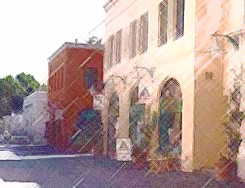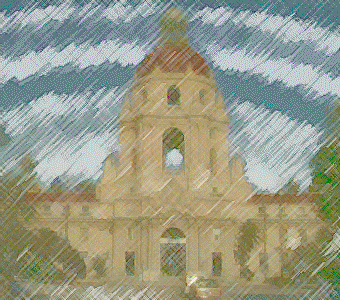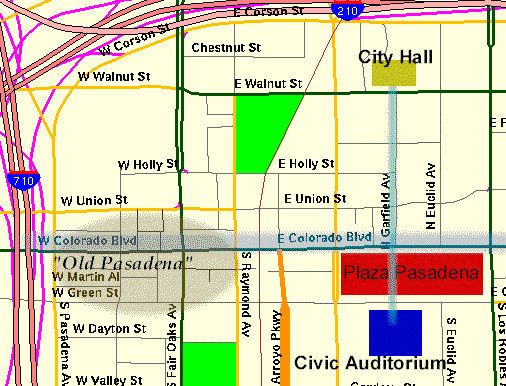
Historic "Old
Pasadena" develops into an
attractive and very busy mixed residential/commercial area with restaurants, theaters and
shops. The adjacent Plaza
Pasadena shopping mall quietly deteriorates as
the retail vacancy rate rises to more than 50%.
(1998-1999)
Pasadena approves $100 Million to remodel the Plaza Pasadena. Plans
include partial demolition to re-open the Civic Center corridor between City Hall and the
Civic Auditorium and to reorient the interior stores to face Colorado Boulevard.
PLAZA PASADENA
A Case Study in Successful
Failure
REPLACING OLD PASADENA (1971)
(Shopping mall
developer) John Gilchrist believed Pasadena had a community feeling (and) people would
want to shop there if they could. No novel environment was necessary. All
the company had to do was build an ordinary mall. (Frieden
89)
The driving force behind Plaza Pasadena was
the powerful Pasadena Redevelopment Agency (PRA) and its Executive Director, George
Trimble. In 1971 the PRA was an autonomous agency of the
city with an independent source of income (tax-increment financing authority) and a large
available fund balance. After six years of successful work developing office
buildings downtown, Trimble began to focus attention on the Colorado Boulevard shopping
district.
Block after block of Colorado Boulevard,
once a flourishing commercial thoroughfare, had become a source of wounded pride and
sagging revenue. As retailers shut their doors, dead stretches of street frontage
made shopping even less appealing. (Frieden 88)
In 1971, "downtown revitalization" meant "shopping center."
Beginning with the opening of Northland Mall just outside of Detroit in 1954, the
enclosed, air-conditioned suburban shopping mall concept had expanded across the United
States. By 1970, the suburban market for new centers was slowing and developers
began to look at the central cities as a source of new opportunities. City leaders,
with the memory of past Urban Renewal failures still fresh, were ready for a different
approach to downtown revitalization.
The Plaza Pasadena was envisioned as a means to achieving the larger goal of bringing people back
downtown to live, work and shop. It would be a catalyst for revitalization and a
symbol of the rebirth of Pasadena as a whole.
The city partnered with Ernest Hahn, a successful developer of suburban shopping malls,
to translate his product to a downtown location. Hahn would construct the building
and secure tenants while the PRA would purchase and clear the site. Suburban-style
shopping malls are low-density, acreage-hungry uses of land. The Plaza Pasadena would
be spread over three city blocks totaling eleven acres. Land assembly and clearance
costs alone would consume more than $41 million in public funds. Every effort was made to make Ernest Hahn’s development job easier and to limit
outside influences on the project. Public subsidies supported below-cost lease deals
to secure two large department stores as anchor tenants. Public hearings were
conducted with unheard-of speed and carefully orchestrated to insure a minimum of public
outcry. When opposition arose regarding the destruction of the historic Pasadena
Athletic Club, Trimble out-maneuvered his opponents and quickly moved ahead with
demolition. To avoid Federal Government intrusion into the project, the large
and inviting pool of Urban Renewal dollars was avoided entirely.
The city got what it wanted when the Plaza Pasadena opened in 1980 with almost
100-percent of its space leased to a healthy mix of specialty stores. The mall
attracted people back downtown and the long decline in downtown retail sales quickly
reversed. Its initial success opened the door for several large companies to move
their headquarters to the area. New shops quickly began to move into the older
storefronts along Colorado Boulevard.
REPLACING PLAZA PASADENA (1999)
By 1990, the Plaza Pasadena revitalization project had become so
successful that nearby historic "Old Pasadena" began to draw
customers out of the mall.
Along Colorado Boulevard in a colorful
district known as Old Pasadena, crowds of pedestrians clog intersections as they make their way
to shops, restaurants and movie theaters. But fun, and retailer’s profits,
vanish a block to the east at Plaza Pasadena (where) darkened
storefronts illustrate an exodus…from the mall. (White 1)
City officials are now planning to spend $100 million to remodel and revitalize
the mostly-vacant mall, including a plan to demolish part of the mall to re-orient the
focus of the stores towards the street. The mall will be cut in two, restoring the
Civic Center corridor between City Hall and the Civic Auditorium. The Plaza Pasadena design
will be essentially turned inside-out to reconstruct a "Main Street"-style
shopping district from the failed suburban-style shopping center.
A SUCCESSFUL FAILURE
The Plaza Pasadena
downtown shopping mall project did successfully achieve the city’s larger goal to
revitalize the downtown "Old Pasadena" area. The mall itself has essentially
become a casualty of its own success.
Two factors stand
out as vitally important to Pasadena’s successful revitalization efforts. Most
important is a charismatic leader
who is constantly championing the cause to the local elected officials, private business
interests and the public. Also important is the establishment of an
autonomous agency with an independent source of revenue to oversee the
project.
"The fizzles, failures and abandoned
downtown projects far outnumber the successes." (Frieden 85).
Pasadena’s Plaza Pasadena is
unusual in the history of downtown revitalization projects in the 1960s and 1970s.
At a time when Federal dollars flowed freely, Pasadena chose
to complete their new downtown shopping center project solely with local funding.
Most importantly, at a time when most downtown projects were failing, Pasadena
successfully achieved its downtown revitalization goal.
What
mattered most to the success of this revitalization effort was the leadership of a key
person in a local organization who skillfully accumulated the political and financial
power needed to make the city’s vision for a revitalized downtown a reality.
The following comments have been received in response to the information and opinions presented on this page:
Date: Friday, 24 Mar 2000
Subject: Your web history
The hype is wrong. Plaza Pasadena did not lead to Old Pasadena's success. It was a fatally flawed effort to inject suburban development into an urban context. And like other suburban malls designed to meet the needs of specific tenants, it was a prisoner of their fate.
The buildings in Old Pasadena suffered because of inadequate parking. But they were flexible enough to host a long cycle of different users and mixes of users. The mall is not and will be completely revamped.
Don't believe everything you read.
Rick Cole, Former Mayor of Pasadena '92-'94
ACKNOWLEDGMENTS
Frieden, Bernard J. and Lynne B. Sagalyn. 1990. Downtown Inc.: How
America Rebuilds Cities. The MIT Press: Cambridge MA.
White, Michael. June 14, 1998. "Retailers Moving Away From
Enclosed Malls, Seek Open Space, Foot Traffic." http://gr.mlive.com/realestate/stories/19980612retailers.html
INTERVIEW with John Andrews. Housing
and Development Department, City of Pasadena. February 26,
1999
Nanney, Rodney C. February 2, 1999. "How We Rebuild Our
Downtowns."
Downtown Pasadena Map. http://www.mapsonus.com
Pasadena Images. http://ci.pasadena.ca.us
WebAuthor: Rodney
C. Nanney nammeroo@juno.com
.


 Pasadena spends $41 Million to build the Plaza Pasadena shopping mall along Colorado Boulevard and across Garfield
Avenue in an effort to revitalize the downtown area.
Pasadena spends $41 Million to build the Plaza Pasadena shopping mall along Colorado Boulevard and across Garfield
Avenue in an effort to revitalize the downtown area.
